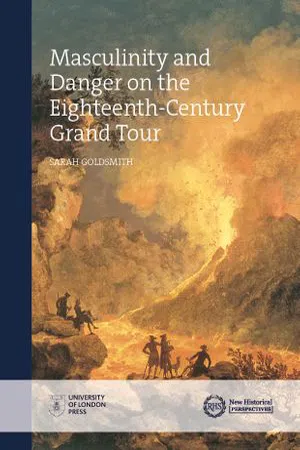
- English
- PDF
- Available on iOS & Android
Masculinity and Danger on the Eighteenth-Century Grand Tour
About this book
The Grand Tour was a journey to continental Europe undertaken by British nobility and wealthy landed gentry during the seventeenth and eighteenth centuries. As a rite of passage, the Tour also played an important role in the formation of contemporary notions of elite masculinity. Examining letters, diaries and other records left by Grand Tourists, tutors and their families, this book demonstrates how the Tour was used to educate elite young men in a wide variety of skills, virtues and masculine behaviours that extended well beyond polite society. Sarah Goldsmith argues that dangerous experiences, in particular, were far more central to the Tour as a means of constructing Britain's next generation of leaders than has previously been acknowledged. Influenced by aristocratic concepts of honour and cultures of military leadership, elites viewed experiences of danger and hardship as powerfully transformative and therefore as central to the process of constructing masculinity. Far from viewing danger as a disruptive force, Grand Tourists willingly tackled a variety of social, geographical and physical perils, gambling their way through treacherous landscapes; scaling mountains, volcanoes and glaciers; and encountering war and disease. Through this innovative study of danger, Goldsmith offers a revision of eighteenth-century elite masculine culture and the critical role the Grand Tour played within this.
Frequently asked questions
- Essential is ideal for learners and professionals who enjoy exploring a wide range of subjects. Access the Essential Library with 800,000+ trusted titles and best-sellers across business, personal growth, and the humanities. Includes unlimited reading time and Standard Read Aloud voice.
- Complete: Perfect for advanced learners and researchers needing full, unrestricted access. Unlock 1.4M+ books across hundreds of subjects, including academic and specialized titles. The Complete Plan also includes advanced features like Premium Read Aloud and Research Assistant.
Please note we cannot support devices running on iOS 13 and Android 7 or earlier. Learn more about using the app.
Information
Table of contents
- _GoBack
- _GoBack
- _GoBack
- _GoBack
- _GoBack
- pb-282
- _GoBack
- _GoBack
- Introduction
- Figure 2.1. Map and key of sites where Grand Tourists engaged with military activity, c.1730–80.
- Figure 2.2. A two-week daily timetable, written by Herbert’s parents in 1776, for his stay in Strasbourg. Wiltshire and Swindon History Centre, MS. 2057/F4/278, ‘Instructions’, 1776. Repr. by permission of the 18th earl of Pembroke and Montgomery and the
- Figure 2.3. Pompeo Batoni, ‘Sir Watkin Williams-Wynn, Thomas Apperley and Captain Edward Hamilton’, (NMW A 78, 1768–72). Permission of Amgueddfa Genedlaethol Cymru/National Museum of Wales.
- Figure 3.1. Pompeo Batoni, ‘Alexander Gordon, 4th duke of Gordon (1743–1827)’ (NG 2589, 1763–4). Permission of National Galleries of Scotland. Purchased by Private Treaty with the aid of the National Heritage Memorial Fund and the Art Fund 1994.
- Figure 3.2. Anon, ‘The leap in height with & without a pole’ from Christian Salzmann, Gymnastics for Youth… (London, 1800), 215. Credit: Private Collection Look and Learn/Barbara Low Collection/Bridgeman Images.
- Figure 3.3. Pietro Fabris, ‘Kenneth Mackenzie, 1st earl of Seaforth 1744–1781 at Home in Naples: Fencing Scene’ (PG 2610, 1771). Credit: National Galleries of Scotland/Bridgeman Images. Purchased 1985 with the assistance of the Art Fund.
- Figure 4.1. Joseph Wright of Derby, ‘Vesuvius from Portici’ (97.29, c.1774–6). Courtesy of the Huntington Library, Art Collections and Botanical Gardens, San Marino, California. Purchased with funds from the Frances Crandall Dyke Bequest.
- Figure 4.2. Michael Wutky, ‘Eruption of Vesuvius, seen across the Gulf of Naples’ (GG-742, c.1790/1800). By permission of Gemäldegalerie der Akademie der bildenden Künste Wien/The Paintings Gallery of the Academy of Fine Arts Vienna.
- Figure 4.3. Pierre-Jacques Volaire, ‘Vesuvius Erupting at Night’ (CVCSC:0343.S, 1771). By permission of Compton Verney, Warwickshire, UK and Bridgeman Images.
- Figure 4.1. Joseph Wright of Derby, ‘Vesuvius from Portici’ (97.29, c.1774–6).
- Figure 4.2. Michael Wutky, ‘Eruption of Vesuvius, seen across the Gulf of Naples’ (GG-742, c.1790/1800).
- Figure 4.3. Pierre-Jacques Volaire, ‘An Eruption of Vesuvius by Moonlight’ (CVCSC:0259.S, 1774).
- Figure 4.4. Pierre-Jacques Volaire, ‘Vesuvius Erupting at Night’ (CVCSC:0343.S, 1771).
- Figure 4.5. Jakob Philipp Hackert, ‘An Eruption of Vesuvius in 1774,’ (Neg. Nr. M10111, c.1774–5).
- Figure 4.6. Detail of Jakob Philipp Hackert, ‘An Eruption of Vesuvius in 1774’ (Neg. Nr. M10111, c.1774–5).
- Figure 4.7. Michael Wutky, ‘The Summit of Vesuvius Erupting’ (GG-390, c.1790/1800).
- Figure 4.8. John ‘Warwick’ Smith, ‘from Album of Views in Italy, [24] Crater [of Vesuvius]’ (T05846, 1778).
- Figure 4.9. Henry Tresham, ‘The Ascent of Vesuvius, 1785–91’ (B1977.14.6296, 1785–91).
- Figure 4.10. Pietro Fabris, ‘Interior view of Crater of Mount Vesuvius … plate IX’, from William Hamilton, Campi Phlegraei (Naples, 1776).
- Figure 4.11. John Shackleton or James Dagnia, ‘William Windham II (1717–61) in the uniform of a Hussar’ (NT 1401251, Felbrigg, Norfolk, 1742–67).
- _GoBack